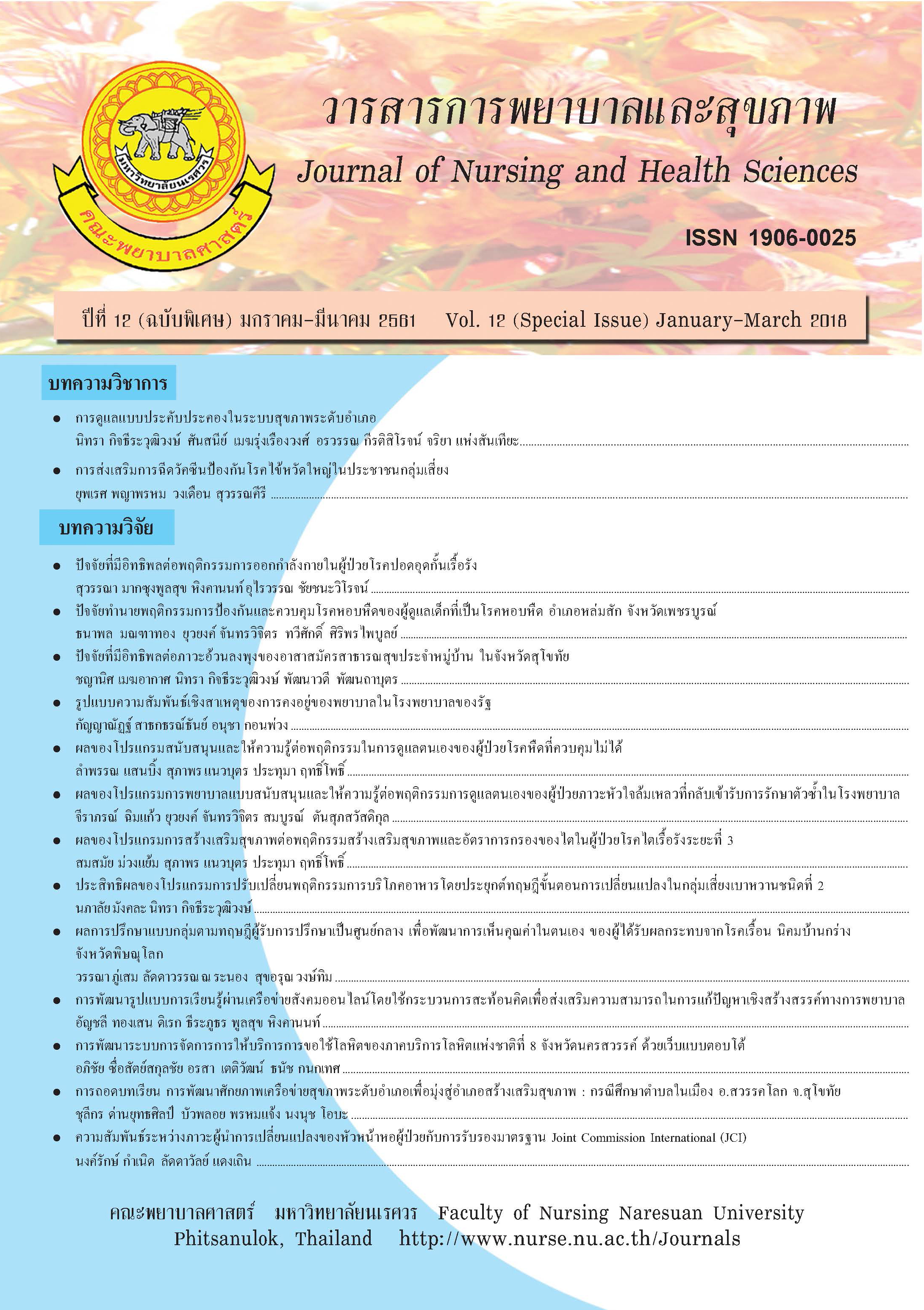Factors Affecting Exercise Behavior Among the Chronic Obstructive Pulmonary Disease Patients
Main Article Content
Abstract
The purposes of this descriptive research wereto: (1) study health belief in exercise behaviors of Chronic Obstructive Pulmonary Disease patients (2) study exercise behaviors of Chronic Obstructive Pulmonary Disease patients and 3) examine factors affecting exercise behaviors and health belief of exercise behaviors of Chronic Obstructive Pulmonary Disease patients. The sample comprised of 151 Chronic Obstructive Pulmonary Disease patients who had been treated in community hospitals in Chainat Province using multistage random sampling. Research instruments included personal data, exercise behavior, and health belief of exercise behavior questionnaires. The instruments were tested for Cronbach’s alpha reliability coefficients. The exercise behaviors and the health belief of exercise behaviors questionnaires had reliability of 0.88 and 0.96, respectively. Data were analysed by using descriptive statistics and Stepwise Multiple Regression. The findings were as follows; (1) Chronic Obstructive Pulmonary Disease patients had health belief in exercise behaviors at high level (Mean = 4.17, SD. = 0.37),(2) Chronic Obstructive Pulmonary Disease patients had exercise behaviors at moderate level (Mean = 2.92, SD. = 0.51), (3). The factors affecting exercise behaviors of Chronic Obstructive Pulmonary Disease patients were cue to action, perceived barriers and age. These factors could be able to predicted exercise behaviors at 27.8 percents (p < 0.001) among Chronic Obstructive Pulmonary Disease patients.
Article Details
References
ความเชื่อด้านสุขภาพการรับรู้อาการเตือนและ
พฤติกรรมการจัดการโรคหลอดเลือดสมอง
ในกลุ่มเสี่ยงโรคหลอดเลือดสมอง อำเภอ
ดอยสะเก็ดจังหวัดเชียงใหม่.(การค้นคว้าแบบ
อิสระ สาธารณสุขศาสตรมหาบัณฑิต. บัณฑิต
วิทยาลัย , มหาวิทยาลัยเชียงใหม่).
นันทวดี ดวงแก้ว. (2551). ความเชื่อด้านสุขภาพและ
พฤติกรรมการป้องกันโรคของกลุ่มเสี่ยงโรค
เบาหวาน อำเภอเกาะคา จังหวัดลำปาง. (การค้นคว้า
แบบอิสระ สาธารณสุขศาสตรมหาบัณฑิต.
บัณฑิตวิทยาลัย : มหาวิทยาลัยเชียงใหม่).
ระบบรายงานเขตสุขภาพที่ 3 กระทรวงสาธารณสุข.
อัตราป่วยผู้ป่วยโรคปอดอุดกั้นเรื้อรังปี 2559.
สืบค้นเมื่อ 20 สิงหาคม 2559,จาก http//mis_
kp.kpo. go.th.miszone3.
โรงพยาบาลหันคา กลุ่มการพยาบาล. (2554). แนวปฏิบัติ
ในการวางแผนการจำหน่ายผู้ป่วย ปี 2554.
หันคา:โรงพยาบาล
สมจิต หนุเจริญกุล.(2545). การพยาบาลอายุรศาสตร์
เล่ม 2.กรุงเทพฯ: วี.เจ.พริ้นติ้ง.
สุรินธร กลัมพากร.(2554).การสร้างเสริมสุขภาพและ
ป้องกันโรคในชุมชน: การประยุกต์แนวคิด
ทฤษฎีสู่การปฏิบัติ. ขอนแก่น: มหาวิทยาลัย
ขอนแก่น.
เสก อักษรานุเคราะห์. (2539).ตำราเวชศาสตร์ฟื้นฟู
เล่ม 1. กรุงเทพฯ: สมาคมเวชศาสตร์ฟื้นฟูแห่ง
ประเทศไทย.
เสก อักษรานุเคราะห์. (2543). การออกกำลังกายสายกลาง
เพื่อชะลอความแก่.กรุงเทพฯ: เวชศาสตร์ฟื้นฟู
คณะแพทยศาสตร์ จุฬาลงกรณ์มหาวิทยาลัย.
สำนักระบาดวิทยา กรมควบคุมโรคกระทรวงสาธารณ
สุข. 2554. สรุปรายงานการเฝ้าระวังโรค 2554.
กรุงเทพมหานคร: องค์การรับส่งสินค้าและ
พัสดุภัณฑ์
อัมพรพรรณ ธีรานุตร, สุวรรณา บุญยะลีพรรณ, เจียมจิต
แสงสุวรรณ, และวลัยพร นันท์ศุภวัฒน์.(2539).
รายงานการวิจัย เรื่อง: การศึกษาพฤติกรรมการ
ดูแลตนเองของผู้ป่วยโรคปอดอุดกั้นเรื้อรัง.
ขอนแก่น: คณะพยาบาลศาสตร์มหาวิทยาลัย
ขอนแก่น.
American College of Sports Medicine. (2000). ACSM’
s guideline for exercise testing and prescription
(6th ed.). Philadelphia: Lippincott.
Becker, M.H., (1974). The health belief model and
personal health behavior. New Jersey: Charles
B, Slack.
Becker, M.H., &Maiman, L.A. (1975).Sociobehavioral
determinants of compliance with health and
medicalcare recommendation. MedCare,13
(1),10-24.
Blackler, L., Mooney, C., & Jones, C. (2004). Palliative
care in the management of chronicobstructive
pulmonary disease. British Journal of Nursing,
13(9),518-521.doi:10.12968/bjon.2004.13.12960
Gift, G. A., Plaut, M., &Jacox A. (1986).Psychologic
and physiologic factors relate to dyspneain
subjects with chronic obstructive pulmonary
disease. Heart & Lung, 15(6), 595-601.
Global Initiative for Chronic Obstructive Lung Disease.
(2009). Pocket guide to COPD diagnosis,
management, and prevention. Retrieved July
18, 2009, from http://www.goldcopd.org
Hilling, L., & Smith, J. (1995).Pulmonary rehabilitation.
In J. E. Hodgkin, & T. L. Peety (Eds.),Chronic
obstructive pulmonary disease: Current
concept. Philadelphia: W.B.Saunders.
World Health Organizition.(2008).The world Health
report 2008. Geneva: WHO.


